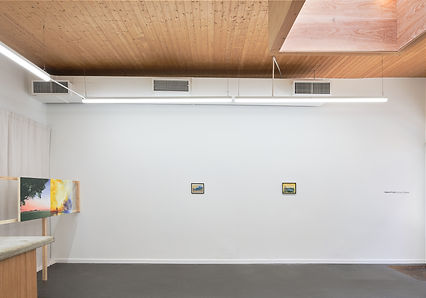
Aaron Ford, Djebel Bou Korine, Gulf of Tunis, 2025, oil on canvas, 24 x 31 1/2 inches (60 x 80 cm)
Aaron Ford: Lotos-Eaters
Opening reception: Friday, September 5th, 6 - 8pm
Exhibition: September 5th - October 11th, 2025
Friday & Saturday, 10am - 6pm
& by appointment
35 Lispenard Street, New York, NY 10013
“Nine days I drifted on the teeming sea before dangerous high winds. Upon the tenth we came to the coastline of the Lotos Eaters, who live upon that flower. […] I sent out two picked men and a runner to learn what race of men that land sustained. They fell in, soon enough, with Lotos Eaters, who showed no will to do us harm, only offering the sweet Lotos to our friends, but those who ate this honeyed plant, the Lotos, never cared to report, nor to return: they longed to stay forever, browsing on that native bloom, forgetful of their homeland.”[1]
We find ourselves here, at Homer’s description of the ancient Greek hero Odysseus’ encounter with the Lotus Eaters in his epic poem The Odyssey. ‘Here’ is where the artist also finds himself: on Djerba, a small island off the southern coast of Tunisia, where ancient historians place this Land of Lotus Eaters, an island where “the inhabitants of Meninx (Djerba) closely correspond to the description of the Lotophagi (lotus eaters)”[2]
Ford’s concern is the migration of images, the movement of iconography across the Mediterranean, between the African and European continents. While searching for an ancient dye in Tunis, he made a trip to Djerba, unknowingly wandering into the Land of the Lotus Eaters.
The two largest paintings in the show, Djebel Bou Kornine, Gulf of Tunis and Land of the Lotus Eaters (After Moran), depict Ford’s own photographs of Tunisia as well as a detail of North American painter Thomas Moran’s depiction of the fruit-munching inhabitants’ island.
This thread leads to German expressionist painter Gabriele Münter’s photo archive from her and Wassily Kandinsky’s trip to Tunisia (1904-1905). It is her image and photographs that populate the works of Gabriele Münter and Gabriele Münter (Detail), as well as Donkey and Parade, the works on paper and glass.
In using found frames and painting directly on the glass and wooden bars, the paper is couched within these readymade objects. Ford thereby extends the tradition of glass painting onto a contemporary support. By looking at imagined places through the eyes and lens of others, Ford codifies his own experience into painting, at once assembling and collapsing a depiction of space: one which exists physically off the coast of North Africa, but emotionally within a selection of grouped experiences.
In his poem The Lotos-Eaters, Alfred Tennyson dignifies the three men who indulge in eating the lotus fruit. They are not decadent Dionysiac revellers: their decision to eat the fruit is a choice, a philosophical conclusion to their journey which has become a quest without end.
Perhaps within the lotus fruit we find the possibility of experience, one shared, or enjoyed as a solipsistic exercise, a collapse of understanding, a collection of images, grouped by their ability to suggest a sensation of history, real or imagined.
“They sat them down upon the yellow sand,
Between the sun and moon upon the shore;
Most weary seemed the sea, weary the oar,
Weary the wandering fields of barren foam.
Then some one said, "We will return no more;"
And all at once they sang, "Our island home
Is far beyond the wave; we will no longer roam." [3]
[1] The Odyssey by Homer, translated by Robert Fitzgerald
[2] Strabo, Geography, 1.2.17, 17.3.17
[3] Alfred Tennyson, Lotos-Eaters, V, 37-45





Installation photography courtesy of Bradley Farwell
